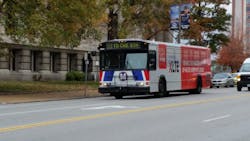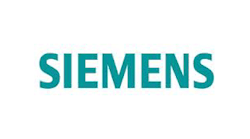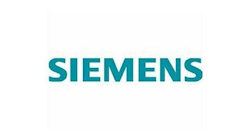The Bi-State Development Agency in St. Louis, Missouri, was originally formed to be an economic development agency for the bi-state region — three counties in Missouri plus the city of St. Louis and three counties in Illinois. It’s modeled after the Port Authority of New York & New Jersey and was incorporated by an act of Congress in 1950. Bi-State Development Agency President & CEO John Nations said, “What we’re really formed to do and what we actually do is to provide real regional solutions to regional challenges.
In the 50s, transit in the St. Louis region was done by 15 private firms. They lacked coordination and riders were discouraged. Nations said in the early 60s, the region came to the agency to solve the problem and it bought those companies. In 1963 it officially took over operations of the transit operations and operated them as a unified single system under the name Metro.
The agency also operates the St. Louis Downtown Airport, the Port of Metropolitan St. Louis, the operation of the Gateway Arch as part of the Jefferson national Expansion Memorial, excursion boats on the Mississippi River, and most recently freight for the region.
It’s not a taxing authority; instead the transit service is according to the resources of the communities and their desires with regard to the level of service that they want. The agency puts a service package together for St. Louis County, Missouri, the city of St. Louis, and St. Clair County, Illinois and then turn the whole thing in to a region-wide transit system.
Collaboration with Metro
Nations’ background is in the private practice of law, where he focused primarily in corporate law, land use, real estate and development, public finance, and economic incentives.
In 1993 the Chesterfield Valley flooded, it was mostly farmland. Nations lost an election running for office saying the valley needed to be developed. People said that shouldn’t happen and he lost. He ended up getting involved in the city after that and ended up on the city’s industrial development board, on the TIF Commission and became chairman of the TIF Commission. They did a $72 million TIF and put in infrastructure; not the developments themselves, but the infrastructure. “People started to look at it and say that was the right thing to do,” he said. “We developed Chesterfield Valley from an inundated floodplain in 1993 to what is widely considered one of the best uses of tax increment financing in the country.”
When he was 38 he was elected mayor of Chesterfield and in the spring of 2009, transit service to Chesterfield was going to be eliminated due to funding constraints. Nations said there were 26,000 full-time jobs in the city of Chesterfield and while not all of them take transit, when it comes to the nursing homes, hospitals, a lot of the retail space, they depended on it. He said he worked out a deal with Metro, putting up city funds in order to keep the buses running. And, it was all over the news.
Nations said, “The problem with public transit in most places, people look at it like it’s a public assistance program and not like it’s an essential element of an economic development strategy.” He continued, “To me it’s an essential element of an economic development strategy.
“When you look at economic development, what are the elements of economic growth? What are the elements of a successful community? You have to have good neighborhoods, you have to have good schools, you have to have job opportunities, you have to have good infrastructure. One of the things you need to have is good public transportation.”
After this, he was asked if he would be interested in being president of the Bi-State Development Agency. It was a nice conversation he had with them, Nations said, but he felt it was synonymous with transit, run as a transit company, and his background wasn’t in transit. “My background is economic development, job creation, putting deals together, putting public-private partnerships together to put infrastructure in, creating jobs, that’s what I do,” said Nations. “That’s my passion; I am not a career transit guy.”
A few months later he was called by the agency to help in getting a sales tax to support transit in St. Louis County. It had been put on the ballot twice before and had failed twice before. It was late 2009, early 2010. The Tea Party was on the rise, there an anti-tax sentiment, and the economy was in bad shape. Nations said, “You’re talking about going out to the voters and saying, ‘By the way, we want to pass another tax.’”
He led the campaign and there was more than 60 percent of the voters voting for it.
Rather than look at public transit like a public assistance program, he said they would go out night after night campaigning around different themes. “We’re trying to help people lead better lives, get a better job, make tomorrow better than today, create economic opportunity and that’s how we fit in to the economic development equation,” Nations explained.
Nations was asked to come in again to talk to the board about being president and was offered the position. While people think because they’re in the news most about public transit, that public transit consumes his day, said Nations. His day may begin meeting with the Secretary of the Interior in Washington, D.C., and it could end standing in Union Hall talking to transit employees, or over at the airport. “When you’ve got a guy like Ray Friem who can run it, transit actually as the functioning entity and the business of it occupies a minority of my time. “
Maintenance Rehab
Chief Operating Officer of Transit Services Ray Friem’s background is as a rail car fleet manager. He had good training in systems from the Navy, running a system on an aircraft carrier that touched a lot of other systems. “I was trained to be aware of touchpoints and to be able to think if I do this, how’s it going to effect this other group over here? That training was invaluable for transit,” he said.
After the Navy he was in Pittsburgh, and then came to St. Louis where the Siemens fleet is getting ready to turn 100 million miles. While he had no experience in buses, it was the accounting department that put him as the bus manager guy, he said.
“What happened really, the cost of LRV maintenance kept going down; we kept refining it,” he said. In 2000 they were $500,000 less than in 1998 and the bus side was $11-1/2 million more. And struggling. He added, “The term I used for it then was Third-World Bogotá bad.
The separate garages were run in competition of each other, with a lot of hostility. “I’m listening to these guys talk. We had amain shop and we had these satellite garages and our procurement department is a different group and when you bring them all together in a room, you literally needed UN peacekeepers,” Friem explained.
When a bus had to be sent to the main shop, it was taking 135 to 160 days from the day it got there to get out. If an engine or transmission was bad, they knew if they sent it they were never going to see it again. And they all needed parts in their own garages, so before sending it over, they would steal everything out of it that was working. Friem said, “There was nothing left functional. We were getting these hulls that had to be completely rebuilt … they stole everything.”
The agency was rebuilding 150 engines a year and spending massive amounts of overtime – millions of dollars. They went out to buy 240 buses to have them delivered by the end of 2000 to the mid part of 2012. Friem explained it’s a 470 bus fleet and more than 200 buses were coming in right as he was appointed chief mechanical officer. The mean distance between failures was around 3,400. “Fifty percent of the fleet is going to be brand new. Mean distance between failures is going to 6,000. I’m a hero if I don’t do anything,” he said. “All I have to do is sit here and smile for two years and get the Hell out of here because it’s all going to happen again.”
Friem said he had his eureka moment when the head guy at the main shop took him out to look at the retired buses. As a new bus would come in, one would get set down. He said, “I would say open up the engine and you would see this engine that’s clean; it’s got the green tag.”
Looking at the history from the time at the main shop until they got done with and it’s 160-day evolution and they had spent $80,000 on it and then sent it back out. It would run again for five to six months, maybe 40,000 miles and then it was getting retired.
“All this work, all this money and buses are going out there and getting pounded to 60/65,000,” said Friem. “So I’m investing millions of dollars in things I’m going to throw away. I’m murdering my brand new rolling stock and everybody hates each other. There’s got to be a better way,” he said.
The Plan
The starting point was determining where they wanted to make the investments. Making a $100,000 investment in the last 6 months of the buses life isn’t good for the agency or for the customer. He said he started to look at midlife, at about 350,000 miles.
Friem said, “If I had tried to go to the bus and say this is how we did it in rail and this is how we’re going to do it, I would have failed. You had to be willing to play to the strength of the team.”
Each of the managers was assigned a segment of the fleet. They were to go back in the system, M4 Maximus system at the time, and had to calculate how much was spent on that fleet of buses the previous year. “It was selectively chosen who got what,” said Friem. “I tried to make sure that the reports were going to be honest and quite frankly, based on their level of hatred for each other, probably rather damning.”
When they came back with the reports, he mapped out how much they were spending on buses and when they were spending those amounts. They weren’t doing anything to the bus until there were terrible problems. In the middle of its life they started spending a bit more and then it got huge at the end. So they were making all of the investments in year 7 to 12.
Next was looking at what they were fixing. They looked at the top 25 components they were replacing on the system and how many miles were on it since the last time it was replaced. If a failure was coming at 125,000 miles, they would replace it at 100,000. Friem said they screamed. They didn’t have time to replace good parts. His response was that they didn’t have time not to.
“Suddenly we had all kinds of time,” Friem said. When they took a part off at 100,000 before it failed, it’s a functional component. “At 100 I take it off, clean out the bearings, do some electrical testings, I put it back, it’s good for another 125,” he said. “But, if it melts down, it’s toast. The cost to rebuild this thing is $600. Molten metal, $2,500.
“I’m making 1,900 bucks right away — more than enough to cover the cost of a mechanic to replace it when it was still good.”
In 2000, the mean distance between failures was at 3,400 and within the second year of the new plan, they were close to 10,000 miles, to more than 22,000 miles in FY 2014.
The target for the bus life is now 15 years, 825,000 miles. Previously it was 12 years, 600,000 miles. Friem said, “We’ve immediately saved 25 percent of our capital budget going forward.” The major investment points are at 200,000, 400,000 and 600,00 and the weighted average cost is that they’re not spending that much at the beginning or the end of the life of the bus.
Darren Curry, chief mechanical officer, said that their new buses, 1 to 2 years old, are running about 5 cents a mile. “The buses that are sitting down there, ready to go up for auction … they’re operating at 19 cents a mile.”
“That’s a bus with 750,000-plus miles on it,” Friem stressed.
The plan only works if you have a capital replacement plan to support it,” Curry said. “You can do great maintenance, but if you’re not committed to the replacement of that vehicle to the target that you’re going to land, you might extend a little but eventually you’re going to go under.”
Friem said they need to change the capitalization plan, they needed a fixed replacement schedule. “We are going to buy 1/15th of our fleet every year, like clockwork. Now the region knows exactly how much capital I need.”
To catch up to a point of a fixed replacement schedule, to even out the fleet age, they purchased 15 refurbished articulated buses from Complete Coach Works at a fraction of the cost of a new bus. Curry said at one point Friem came down to the shop where they had a 2008 bus that had just gone through a midpoint, including painting, a brand new Gillig bus and one of the refurbished buses they had recently purchased. “I asked what do you think of the refurbished bus and he asked, ‘OK, which one is it?’ No one can tell what’s a new or old bus anymore.”
Curry said Friem changed the conversation. “We got tired of complaining of what we don’t have or what we can’t, to this is what we’re going to do.” Curry continued,” We all came in at the right time. Ray came in and organized, had the vision that there’s a better way to do it. Carl [Thiessen] came in and put it all together. I came in and I’m trying to enhance and push it further along because I have the time.”
Next Stop: Smart Bus
The Smart Bus Project is the next phase of the maintenance program. With I/O Controls’ Dinex G3 Multiplex System, anything that the multiplex system touched, they could measure it, they could count it, so they could predict it. Curry said they really started pushing what its capabilities were and eventually contacted the designer to open up a dialogue.
They got to the point that the bus can start itself and run through its own pre-trip inspection and email its findings. They’re still in the process, ensuring all the proper controls are in place.
As good as the planned maintenance is, Curry said, it’s currently mileage based and based on the heaviest duty cycle. “What we’re going to move to is a condition-based, all the way down to the component itself. In addition to that,” he added, “we’ll be able to look at how it’s operating – we’ll look at the predictive side.”
As long as the bus is operating in its given parameters, it will go the full cycle but if it operates outside its parameters, the bus will generate its own order.
“In the future … you could have buses that are ordering its own parts with its own approved vendor list,” Curry said. “The bus orders its own part and it arrives two or three days ahead of the bus being scheduled in.” He continued, “Where you rethink storerooms where you have bins with part numbers on it, instead you have bins with bus numbers on it.”
The ROI of Transit
Nations said public transportation isn’t just about getting a bus down the street or a train down the street. “Who’s on that bus? Where are they going? How can we create opportunity for them? How can we bring jobs into the region and create more opportunity for everyone?”
“… I think the entire public transportation industry suffers from viewing itself and consequently having itself viewed by others, as a public assistance agency. Just the way we talk about it,” stressed Nations. “Stop talking about how you need a public subsidy. No, I don’t. People say you’re going to run out of money and I said I’m never going to run out money.
“Why? Because I’m only going to put on the street what I get paid to put on the street. And that has been changing the conversation here in St. Louis.”
Nations compared what his ideology was as mayor and how that translates in transit management. “You create the prosperity but you have to have the engine to do it and then you make sure the prosperity gets returned to the people in the form of better services, better amenities.
“How can I take my system, when it comes to transit, and improve an area?
“If you look in St. Louis,” he said, “some of the best developments are right around the Metrolink line. It’s all around transit.”
While they go through an appropriation process every year, one of the things Nations said they are proud of is that they have been able to show that the efficiencies are good, that they’re running the company to the best of their abilities.
Nations said, “What Ray Friem does and what his team does, gives me the confidence to go to our funding partners and say this is where we are, this is how we compare to our peer groups across the country. We don’t believe you can find a better investment for public transit in St. Louis than us and we’ll be glad to put our operation up against anybody.”






